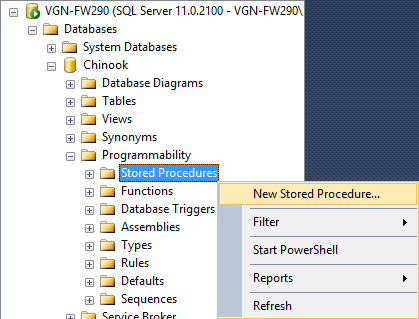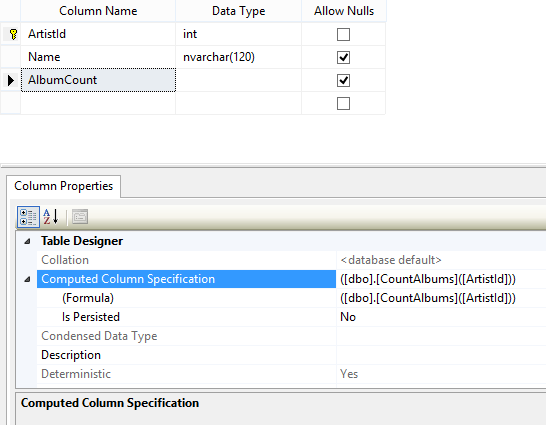Chinook SQL Server Database
The Chinook Database is a sample database available for SQL Server, Oracle, MySQL, PostgreSQL, SQL Server Compact, SQLite and more. It is ideal for demos, application prototypes and perhaps even a digital media store application. It includes tables for artists, albums, media tracks, invoices and customers.
Download and Installation
Download the Chinook database from GitHub.
Chinook Database
Make sure you can Access your SQL Server [Configure Windows Firewall]
Connection String
<connectionStrings>
<add name="ChinookConnection" providerName="System.Data.SqlClient" connectionString="Data Source=VGN-FW290\SQLEXPRESS;Initial Catalog=Chinook;Integrated Security=True" />
<!-- using account without SQL Express
<add name="ChinookConnection" providerName="System.Data.SqlClient" connectionString="Data Source=VGN-FW290;Initial Catalog=Chinook;Persist Security Info=True;User ID=sa;Password=***********" />
-->
</connectionStrings>
* VGN-FW290 is the name of my computer. Replace this with your computer name
SQL Stored Procedures
SQL Server 2012 Express Management Studio
Open up SQL Server Management Studio and connect to the server that is defined in the connection string. In the Object Explorer F8 Right click on the Stored Procedures node of the expanded Databases.Chinook tree and Select “New Stored Procedure”.

The first stored procedure you will create, GetArtists uses CTE (Common Table Expression) to handle the paging of the records. Especially in web applications, it is a best practice to utilize paging when returning records from large tables.
dbo.GetArtists
CREATE PROCEDURE [dbo].[GetArtists]
(
@Id INT = 0,
@PageSize INT = 0,
@PageNumber INT = 1
)
AS
DECLARE
@FirstRow INT,
@LastRow INT
IF (@Id = 0)
BEGIN
IF (@PageSize = 0) SET @PageSize = (SELECT COUNT(*) FROM dbo.Artist)
SELECT @FirstRow = ( @PageNumber - 1) * @PageSize + 1,
@LastRow = (@PageNumber - 1) * @PageSize + @PageSize ;
WITH Artist AS
(
SELECT ROW_NUMBER() OVER (ORDER BY Name ASC) AS RowNumber,
COUNT(*) OVER () AS TotalCount, *
FROM dbo.Artist
)
SELECT *
FROM Artist
WHERE RowNumber BETWEEN @FirstRow AND @LastRow
END
ELSE
BEGIN
SET NOCOUNT ON
SELECT * FROM Artist
WHERE ArtistId = @Id
END
Create stored procedure GetAlbums for selecting Album(s).
dbo.GetAlbums
CREATE PROCEDURE [dbo].[GetAlbums]
(
@Id INT = 0,
@ArtistId INT = 0,
@PageSize INT = 0,
@PageNumber INT = 1
)
AS
DECLARE
@FirstRow INT,
@LastRow INT
IF (@ArtistId <> 0)
BEGIN
IF (@PageSize = 0) SET @PageSize = (SELECT COUNT(*) FROM dbo.Album)
SELECT @FirstRow = ( @PageNumber - 1) * @PageSize + 1,
@LastRow = (@PageNumber - 1) * @PageSize + @PageSize ;
WITH Album AS
(
SELECT ROW_NUMBER() OVER (ORDER BY Title ASC) AS RowNumber,
COUNT(*) OVER () AS TotalCount, *
FROM dbo.Album
WHERE ArtistId = @ArtistId
)
SELECT *
FROM Album
WHERE RowNumber BETWEEN @FirstRow AND @LastRow
END
ELSE
BEGIN
IF (@Id <> 0)
BEGIN
SET NOCOUNT ON
SELECT * FROM Album
WHERE AlbumId = @Id
END
ELSE
BEGIN
SET NOCOUNT ON
IF (@PageSize = 0) SET @PageSize = (SELECT COUNT(*) FROM dbo.Album)
SELECT @FirstRow = ( @PageNumber - 1) * @PageSize + 1,
@LastRow = (@PageNumber - 1) * @PageSize + @PageSize ;
WITH Album AS
(
SELECT ROW_NUMBER() OVER (ORDER BY Title ASC) AS RowNumber,
COUNT(*) OVER () AS TotalCount, *
FROM dbo.Album
)
SELECT *
FROM Album
WHERE RowNumber BETWEEN @FirstRow AND @LastRow
END
END
Create stored procedure GetTracks for selecting Track(s).
dbo.GetTracks
CREATE PROCEDURE [dbo].[GetTracks]
(
@Id INT = 0,
@AlbumId INT = 0,
@PageSize INT = 0,
@PageNumber INT = 1
)
AS
DECLARE
@FirstRow INT,
@LastRow INT
IF (@AlbumId <> 0)
BEGIN
IF (@PageSize = 0) SET @PageSize = (SELECT COUNT(*) FROM dbo.Track WHERE AlbumId = @AlbumId)
SELECT @FirstRow = ( @PageNumber - 1) * @PageSize + 1,
@LastRow = (@PageNumber - 1) * @PageSize + @PageSize;
WITH Track AS
(
SELECT ROW_NUMBER() OVER (ORDER BY Name ASC) AS RowNumber,
COUNT(*) OVER () AS TotalCount, *
FROM dbo.Track
WHERE AlbumId = @AlbumId
)
SELECT *
FROM Track
WHERE RowNumber BETWEEN @FirstRow AND @LastRow
END
ELSE
BEGIN
IF (@Id <> 0)
BEGIN
SET NOCOUNT ON
SELECT * FROM Track
WHERE TrackId = @Id
END
ELSE
BEGIN
SET NOCOUNT ON
IF (@PageSize = 0) SET @PageSize = (SELECT COUNT(*) FROM dbo.Track)
SELECT @FirstRow = ( @PageNumber - 1) * @PageSize + 1,
@LastRow = (@PageNumber - 1) * @PageSize + @PageSize;
WITH Track AS
(
SELECT ROW_NUMBER() OVER (ORDER BY Name ASC) AS RowNumber,
COUNT(*) OVER () AS TotalCount, *
FROM dbo.Track
)
SELECT *
FROM Track
WHERE RowNumber BETWEEN @FirstRow AND @LastRow
END
END
SQL Function

An efficient way to return an Album Count column in each row is by using a function. This will come in handy when paginating Album records in the UI. Create this user defined function to add a computed AlbumCount column to the Artist Table.
dbo.CountAlbums
CREATE FUNCTION [dbo].[CountAlbums](@ArtistId INT)
RETURNS INT
WITH SCHEMABINDING
AS BEGIN
DECLARE @ArtistAlbumCount INT
SELECT @ArtistAlbumCount = COUNT(*)
FROM dbo.Album
WHERE ArtistId = @ArtistId
RETURN @ArtistAlbumCount
END
Now we need to bind the SQL Function to the Artist table. In the Object Explorer F8, expand the Tables node and Artist table node. Right click on the Columns folder and select New Column from the context menu. Enter AlbumCount under Column Name and int under Data Type. Navigate to the Column Properties tab, expand the Computed Column Specification and enter ([dbo].[CountAlbums]([ArtistId])) for the (Formula) value. Save the Artist table Ctrl+S.

Create stored procedure UpsertTrack for creating and updating track records.
dbo.UpsertTrack
CREATE PROCEDURE [dbo].[UpsertTrack]
@AlbumId int = null,
@Bytes int = null,
@Composer nvarchar(220) = null,
@GenreId int = null,
@MediaTypeId int = 0,
@Milliseconds int = 0,
@Name nvarchar(220),
@TrackId int = 0,
@UnitPrice numeric(10,2) = 0.99
AS
BEGIN
-- SET NOCOUNT ON added to prevent extra result sets from
-- interfering with SELECT statements.
SET NOCOUNT ON;
DECLARE @Exists tinyint
SET @Exists = 0
IF (@TrackId <> 0)
BEGIN
SET @Exists = (SELECT COUNT(*) FROM Track
WITH (NOLOCK)
WHERE TrackId = @TrackId)
IF (@Exists > 0)
BEGIN
UPDATE Track
SET
AlbumId = @AlbumId,
Bytes = @Bytes,
Composer = @Composer,
GenreId = @GenreId,
MediaTypeId = @MediaTypeId,
Milliseconds = @Milliseconds,
Name = @Name,
UnitPrice = @UnitPrice
WHERE
TrackId = @TrackId
END
END
IF (@Exists = 0)
BEGIN
INSERT INTO Track(
AlbumId,
Bytes,
Composer,
GenreId,
MediaTypeId,
Milliseconds,
Name,
UnitPrice
)
VALUES(
@AlbumId,
@Bytes,
@Composer,
@GenreId,
@MediaTypeId,
@Milliseconds,
@Name,
@UnitPrice
)
SELECT @TrackId = SCOPE_IDENTITY()
END
RETURN @TrackId
END
Create stored procedure DeleteTrack for removing track records.
dbo.DeleteTrack
CREATE PROCEDURE [dbo].[DeleteTrack]
(
@Id INT = 0
)
AS
BEGIN
DELETE Track
WHERE TrackId = @Id
END
